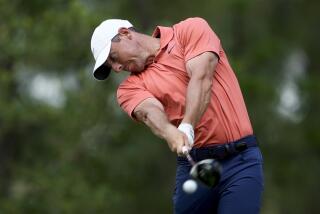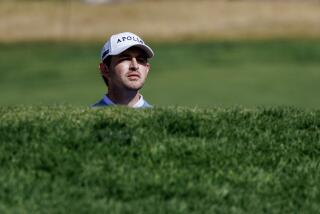His New Swing Is All Sutton Hoped for : After 16 Years, He Gets More Distance--and a 65 to Share Lead
- Share via
PALM DESERT — Hal Sutton is a young man not easily satisfied.
For 16 years, he had a golf swing that enabled him to win the U.S. Amateur, the PGA, more than $1 million in his first four years as a professional and PGA Player of the Year honors in 1983. Last year, he won two tournaments and $365,000.
Good enough? Nosiree.
Two days before the Chrysler Team Invitational last month in Florida, Sutton set out to change his swing.
He said he was advised by a guy named Chico, who, as far as Sutton knows, doesn’t even have a last name.
And why did he decide to change one of the game’s most successful swings?
“I’m getting older and I’m finding that the body won’t do what it used to do,” he said.
Getting older? Sutton will turn 28 on April 28.
In any event, the new swing, grooved in competition in only two tournaments--the team championship and last week’s Tournament of Champions--proved trustworthy Wednesday as Sutton blistered Bermuda Dunes with a 65, seven under par, and earned a share of the first-round lead with Bob Tway in the $650,000 Bob Hope Chrysler tournament.
Tway, a second-year pro, also played at Bermuda Dunes, the host course in this five-day, 90-hole marathon.
One stroke back at 66 were Larry Mize and two pros who have been on and off the tour since 1981, Paul Azinger of Bradenton, Fla., and Jeff Sluman of Rochester, N.Y.
Sluman and Mize had the low scores at Indian Wells, the shortest of the four Hope courses and generally rated the easiest.
Low rounds at La Quinta and Eldorado were 67s, by former winners Bruce Lietzke at La Quinta and Craig Stadler at Eldorado. That put them in a six-way tie with Gary Koch, Jim Thorpe, Gene Sauers and former UCLA star Steve Pate.
Ideal golfing conditions created a spate of subpar scores. Ninety of the 128 professionals bettered par 72 and another nine equaled it.
“It had to be something for me to shoot that low a score,” Sutton said. “It must be the weather.”
It could have been his putter, too.
The handsome Louisianan rolled home three birdie putts of 10 feet or more in his eight-birdie, one-bogey round. He took his only bogey on No. 17, where he needed three putts from 25 feet.
“The greens were much slower than usual at Bermuda Dunes, and I had been putting so well I hit my first putt too hard,” Sutton said. “It hit the back of the cup and rolled about four feet away. It was dead center and would have dropped if I’d hit it easier.
“When the greens are slow, it’s tougher to make those short putts. You have a tendency to slap at the ball instead of taking a smooth stroke like you do on fast greens. I slapped at my second putt and it didn’t go in.”
Sutton said his swing change resulted from a need to get extra distance from his shots.
“I would say I am 20 yards longer, and that’s a conservative number, with my new swing. I used to take my grip and the club head back together. Now, I’m trying to get the club head ahead of the grip. I was hitting the ball just terrible one day down in Florida when Chico was watching me. He said he knew what I was doing wrong.”
Sutton, like every golfer, pro or amateur, was ripe for a suggestion.
“I worked on his idea for two days before the team tournament and noticed the difference,” he said. “Last week at La Costa, I shot 66-67 the last two days and came here anxious to see what would happen. When you play 16 years one way, then try to change in a few days, it’s pretty difficult.
“The results have been rewarding, though. I’m getting more club head speed, which makes for more distance, and the swing should help with my timing and strength as I get older.”
Sutton even made the most of it when he dubbed a shot. On No. 8, a 536-yard par five, he “half-topped” his second shot, then hit a 4-iron shot that stopped six feet from the hole to set up a birdie putt.
The swing wasn’t the only thing new for Sutton. He was using a new set of clubs, having changed for the first time since he joined the tour in 1981.
Tway, who had never played the Bermuda Dunes course before he teed off, said the 70-degree weather proved an inspiration for him.
“I looked at the papers this morning and saw it was about 30 degrees back home in Oklahoma,” he said. “It helped me, just thinking about it.”
Tway, collegiate player of the year in 1981 at Oklahoma State, is looking for his first tour win.
“I knocked at the door a few times last year and I felt the pressure,” he said. “I didn’t win but I felt like I could if I kept working at it.”
Although he has not won on the major tour, Tway won the Sandpiper-Santa Barbara Open in 1983 on the satellite tour.
The 6-4 Oklahoman, who patterns his swing after Tom Weiskopf’s, surged into a tie for the lead with a stretch of four birdies in five holes on the back nine.
“I practiced quite a lot in the off-season and played well in the Bahamas two weeks ago,” Tway said. “This was sort of a carryover.”
The field will shift courses today, with Sutton and Tway taking their lead to the narrow, tree-lined fairways of La Quinta. When all 128 pros have played each course, the survivors will return to Bermuda Dunes for Sunday’s final 18 holes.
HOPE SCOREBOARD
THE LEADERS
Hal Sutton 31-34--65
Bob Tway 33-32--65
THE FOLLOWERS
Jeff Sluman 32-34--66
Paul Azinger 33-33--66
Larry Mize 32-34--66
Steve Pate 33-34--67
Gary Koch 34-33--67
Bruce Lietzke 34-33--67
Jim Thorpe 32-35--67
Craig Stadler 33-34--67
Gene Sauers 34-33--67
THE NAMES
Jerry Pate 33-35--68
Greg Norman 35-33--68
Lanny Wadkins 34-34--68
Nathaniel Crosby 33-35--68
Curtis Strange 32-37--69
Johnny Miller 36-34--70
Ben Crenshaw 36-36--72
Calvin Peete 37-36--73
Arnold Palmer 37-37--74
Tom Kite 36-38--74
More to Read
Go beyond the scoreboard
Get the latest on L.A.'s teams in the daily Sports Report newsletter.
You may occasionally receive promotional content from the Los Angeles Times.










